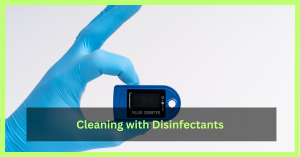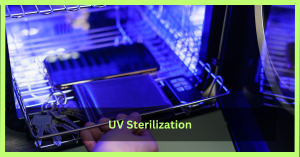
Welcome to our comprehensive guide on how are pulse oximeters sterilized. In this article, we will delve into the various methods and best practices for ensuring that your pulse oximeters remain clean and accurate.
Whether you’re a healthcare professional, a patient, or simply interested in understanding the process, we’ve got you cover. So, let’s explore the world of pulse oximeter sterilization together!
What is a Pulse Oximeter? And How Are Pulse Oximeters Sterilized

Before diving into how are pulse oximeters sterilized, it’s important to understand what a pulse oximeter is. A pulse oximeter is a small, non-invasive device that measures the oxygen saturation level in your blood and your heart rate. It is commonly use in healthcare settings and is now also available for personal use.
Importance of Sterilization
Sterilization of pulse oximeters is crucial to ensure accurate readings and prevent the spread of infections. These devices come into direct contact with patients’ skin, making them susceptible to contamination. By following proper sterilization procedures, we can maintain the highest standards of hygiene and reduce the risk of cross-contamination.
Sterilization Methods
There are several effective methods for sterilizing pulse oximeters. Let’s explore the most commonly use ones:
Method 1: Cleaning with Disinfectants

One of the simplest and most widely use methods is cleaning the pulse oximeter with disinfectants. Start by wiping the device’s surfaces with a soft cloth or disposable wipe soak in an approve disinfectant. Ensure that the disinfectant is safe for use on the device and doesn’t damage its components.
Method 2: Using Ethylene Oxide Gas

Ethylene oxide gas sterilization is a highly effective method for sterilizing pulse oximeters. It involves placing the device in a seal chamber where it is expose to the gas. This method is particularly suitable for heat-sensitive devices and those with electronic components.
Method 3: Autoclaving

Autoclaving is a widely use sterilization method in healthcare settings. It involves subjecting the pulse oximeter to high-pressure steam in an autoclave machine. However, not all pulse oximeters are suitable for autoclaving, so it’s essential to refer to the manufacturer’s instructions.
Method 4: UV Sterilization

UV sterilization is a non-chemical method that utilizes ultraviolet light to kill microorganisms. Pulse oximeters can be sterilize using UV sterilization chambers or UV light devices. It is important to follow the manufacturer’s guidelines for the appropriate exposure time to ensure effective sterilization.
Method 5: Sterile Disposable Covers

Using sterile disposable covers is a practical option to minimize the risk of contamination. These covers act as a protective barrier between the device and the patient, reducing the need for frequent sterilization. Ensure that the covers are compatible with your specific pulse oximeter model.
Common Mistakes to Avoid: How Are Pulse Oximeters Sterilized?
While sterilizing pulse oximeters, it’s important to be aware of some common mistakes to ensure proper disinfection. Here are a few things to avoid:
- Avoid using harsh chemicals or abrasive materials that may damage the device.
- Unless the manufacturer specifically instructs you to do so, avoid submerging the pulse oximeter in water or any other liquid.
- Do not skip cleaning hard-to-reach areas or crevices, as they can harbor bacteria.
Maintenance and Storage Tips
Maintaining and storing your pulse oximeter properly is essential for its longevity and accuracy. Here are a few tips to keep in mind:
- Regularly clean your pulse oximeter, even when it doesn’t require sterilization.
- Store the device in a clean and dry place, away from direct sunlight and extreme temperatures.
- Follow the manufacturer’s instructions for battery replacement and other maintenance tasks.
Sterilization Frequency
The frequency of sterilization depends on the frequency of use and the type of environment the pulse oximeter is use in. Healthcare facilities often have strict protocols for sterilization. However, for personal use, it is recommend to sterilize the device before and after each use or as advise by the manufacturer.
Ensuring Accuracy after Sterilization
After sterilization, it’s crucial to ensure the accuracy of your pulse oximeter. Here are a few steps to verify its performance:
- Check the device’s calibration and accuracy against a known standard, if possible.
- Compare the readings with another reliable pulse oximeter.
- Contact the manufacturer if you notice any discrepancies or have concerns about the device’s accuracy.
Understanding Oximeter Indicators
Pulse oximeters often display indicators that provide additional information about the readings. Here are some common indicators you may come across:
- SpO2 (Oxygen Saturation): This indicator shows the percentage of oxygen saturation in your blood.
- PR (Pulse Rate): The pulse rate indicator displays the number of heartbeats per minute.
Rhetorical Question: Can You Sterilize Pulse Oximeters at Home?
Yes, you can sterilize pulse oximeters at home using appropriate methods such as cleaning with disinfectants or UV sterilization. However, it is essential to follow the manufacturer’s guidelines and ensure proper disinfection to maintain accuracy and prevent damage to the device.
Relevant Analogy:
“Sterilizing Pulse Oximeters is Like Cleaning Your Hands”
Sterilizing pulse oximeters can be like to cleaning your hands. Just as we wash our hands to remove germs and prevent the spread of infections, sterilizing pulse oximeters ensures a hygienic environment and accurate readings.
Precautions for Sterilization
When sterilizing pulse oximeters, it is important to take certain precautions to ensure safety and effectiveness.
- Wear appropriate personal protective equipment (PPE), such as gloves and masks, to protect yourself from chemicals or pathogens.
- Follow the recommend exposure time and concentration of disinfectants or sterilization methods.
- Allow the device to dry completely before using it again to avoid any residual chemicals.
Choosing the Right Disinfectant
When selecting a disinfectant for cleaning pulse oximeters, consider the following factors:
- Check the manufacturer’s instructions for recommend disinfectants.
- Choose a disinfectant that is effective against a wide range of microorganisms.
- Ensure the disinfectant is safe for use on the specific material of your pulse oximeter.
Safety Measures for Ethylene Oxide Sterilization
Ethylene oxide sterilization requires additional precautions due to the potentially hazardous nature of the gas. Here are a few safety measures to follow:
- Conduct the sterilization process in a well-ventilate area or dedicate sterilization facility.
- Adhere to the proper concentration and exposure time to minimize the risks associate with ethylene oxide gas.
- Allow sufficient aeration time to ensure the removal of residual gas before using the pulse oximeter.
Autoclaving Dos and Don’ts
If your pulse oximeter is suitable for autoclaving, keep these dos and don’ts in mind:
- Follow the manufacturer’s instructions for autoclaving parameters, including temperature and pressure.
- Don’t overload the autoclave chamber, as it may hinder proper steam circulation and sterilization.
- Make sure that the pulse oximeter is properly package in autoclave-compatible materials before sterilization.
UV Sterilization Tips
When using UV sterilization for pulse oximeters, consider the following tips:
- Place the pulse oximeter in the center of the UV sterilization chamber for optimal exposure.
- Use the manufacturer’s guidelines regarding the recommend duration and distance for effective sterilization.
- Clean the device before UV sterilization to remove any visible dirt or contaminants.
Conclusion: How Are Pulse Oximeters Sterilized
In conclusion, sterilizing pulse oximeters is essential for maintaining accuracy and preventing infections. By following proper sterilization methods and adhering to the manufacturer’s guidelines, you can ensure the longevity and effectiveness of your pulse oximeter. Remember to prioritize safety and choose the appropriate sterilization method for your specific device.
Frequently Asked Questions (FAQs)
Q1: Can I use soap and water to sterilize my pulse oximeter?
A1: No, using soap and water alone is insufficient for sterilization. It is recommend to follow the manufacturer’s guidelines for appropriate sterilization methods.
Q2: Can I use alcohol-based disinfectants to clean my pulse oximeter?
A2: It depends on the specific device and the manufacturer’s instructions. Some pulse oximeters can be clean with alcohol-base disinfectants, while others may require different types of disinfectants. Refer to the manufacturer’s guidelines for the best cleaning practices.
Q3: How often should I sterilize my pulse oximeter?
A3: The sterilization frequency depends on the use frequency and the environment. For personal use, it is recommend to sterilize the device before and after each use, or as advise by the manufacturer.
Q4: Are there any alternative methods for sterilizing pulse oximeters?
A4: Yes, there are alternative methods such as using hydrogen peroxide vapor or low-temperature sterilization. However, these methods may not be widely available or suitable for all pulse oximeters. Refer to the manufacturer’s instructions for approve sterilization methods.
Q5: Can I sterilize my pulse oximeter with UV light from the sun?
A5: No, sunlight or UV light from non-medical sources is not recommend for sterilizing pulse oximeters. It is best to use specialize UV sterilization chambers or devices design for this purpose.





